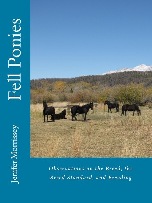Eyes in the Back of My Head
/My first horsemanship mentor had three stallions at their facility when I was visiting and helping out there. They also kept my first Fell Pony stallion after I bought him until I felt my horsemanship was up to having a stallion at my place. One of the first rules they shared with me was, “Never turn your back on a stallion.”
I now have my fifth Fell Pony stallion. The relatively mellow nature of our breed means it can be easy to be complacent around stallions, so I try to keep my mentor’s advice in mind. For me, it is often about turning on ‘the eyes in the back of my head’ when I turn my back to a stallion. I raise my awareness of where the pony is and how far from me before I turn my back to them, keeping my senses tuned so that I return my gaze to them if they approach me so I can manage our interaction.
Now that it is spring, there is green grass in my stallion grazing paddock. The gate is at the bottom of the incline that is the stallion paddock, so I walk with my stallion from the top to the bottom. I have taught him to walk calmly beside me with no tack, stopping and starting when I do. Nonetheless, his energy can be high in anticipation of green grass, and because it’s breeding season, mares and mating are on his mind. So I am extra mindful about watching using either the eyes in the front or the back of my head.
At the bottom of the hill, I ask him to stop ten feet from the gate and stand still. If he moves, I ask him to return to where I left him. Then I move to the gate to open it. The eyes in the back of my head get a workout since I turn my back to my stallion to get the gate unlatched. Once I have the gate ready to open, I make sure my stallion is still listening to my direction, only moving toward the grazing paddock when I invite him.
I am always mindful of how quick our ponies can be. A colleague told me a story of entering a paddock where there was a three-year-old colt (‘colt’ because he hadn’t bred any mares yet.) My colleague, like me, headed across the paddock to open another gate and in an instant the colt had jumped on them from behind, knocking them to the ground. My colleague is an excellent horseman and took full responsibility for the accident, knowing that they had turned their back on a stallion without fully activating the eyes in the back of their head.
It was very easy to imagine how this sort of accident could have happened. There’s a reason my first mentor gave her rule about never turning your back on a stallion. My stallion has days where he is especially rambunctious and he finds it challenging to contain himself on our walk down the hill towards the gate to the grazing paddock. On those days he will shoulder into me to try to initiate some sort of game, sometimes trotting in place and then trotting off if he gets the reaction from me he is seeking.
I am thankful that my colleague shared their story about their young stallion jumping them. It has helped me to be more mindful to open the eyes in the back of my head when I am with my stallion.
© Jenifer Morrissey, 2021









